Südafrika, mein letztes Land! Ich hätte es fast geschafft! Ich bin nur 700 km von Kapstadt entfernt, am Ende des Kontinents. Aber lassen Sie uns noch nicht feiern, denn es kann viel passieren. Nicht wegen der Straßen, da die südafrikanische Straßeninfrastruktur zu den besten Afrikas gehört (wahrscheinlich hinter Namibia, das z.B. besser abschneidet als Island und bei ähnlicher Bevölkerungsdichte viel besser als die Mongolei (kein Eis und Minustemperaturen müssen auch helfen), sondern über die Menschen, da das Land viel Kriminalität hat. Ich erinnere mich, als ich vor drei Jahren in Johannesburg lebte, wurde ich vor Autodiebstahl gewarnt: "halten Sie Ihre Fenster geschlossen, Sperren Sie sich immer im Fahrzeug, legen Sie Ihre Laptoptaschen nicht auf dem Beifahrersitz, bekommen nicht aus Ihrem Auto aus einem bewachten Parkplatz oder eine Tankstelle und schließlich in der Nacht, Sie müssen nicht an roten Ampeln anhalten siehst du Leute aus deiner Umgebung". Es war ein bisschen übertrieben, aber Verbrechen geschieht.
Also, wie soll ich damit auf dem Fahrrad zu bewältigen? Wie kann ich meine Fenster geschlossen halten? Tatsache ist, dass jemand an ein neues Land für die Arbeit oder Geschäft, dass "betriebsbereit" so schnell wie möglich, und dafür, mühelos ein Paket von Sicherheits-Richtlinien, Vorurteile, Kollegen und charakterlos Ausflug Optionen erhalten. Auf der anderen Seite der Reisende muss auf seinen eigenen Reim darauf, werden mehr frei zu experimentieren, und wird dadurch sammeln mehr ein einzigartiges Erlebnis. Also freue ich mich heute auf neu entdecken South Africa mit einem brandneuen Auge.
Trotzdem ich noch würde nicht gehen ein Spaziergang allein Jo'Burgs Vororten und Townships auf ein relativ teures Fahrrad beladen mit all mein hab und gut, und ich bezweifle, dass jemand gesund, die es versuchen würde. Ein Parameter eigentlich viel wichtiger als das "neue Auge" ist, dass ich nicht Jo'Burg, aber Northern Cape, Western Cape geht. Diese sind die westlichen Provinzen Südafrikas und nicht vergleichbar mit Gauteng Provinz bestehend aus Pretoria und Johannesburg. Die Bevölkerungsdichte in Western Cape liegt bei 45/km2. Northern Cape ist 3.1/km2, 300 mal weniger als Gauteng (680/km2)! Also im Grunde, wenn Sie ignorieren das Abbaugebiet von Kimberley und der landwirtschaftlichen Region von Upington (weit weg im Osten), gibt es hier keine mehr Menschen als in der Namib-Wüste.... In letzter Zeit, ich habe Fragen südafrikanischen Touristen in Namibia über diesen Provinzen, und sie alle antworteten, dass Sicherheit nicht sogar ein Anliegen: "Nordkap ist wie Namibia", sagten sie, so wird es perfekt für mich. Jedoch finden einige Namibier, die für die Arbeit in SA wurden es gefährlich, ein bisschen wie die vielen Beninese traf ich, nach Nigeria gehen würde, auch wenn sie bezahlt wurden.
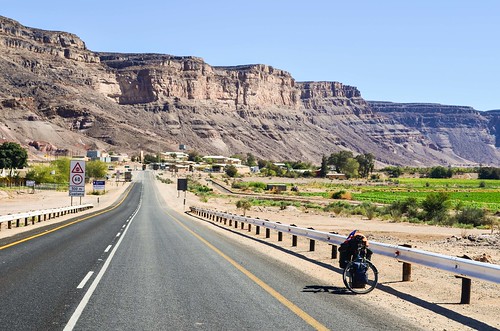
Namibia ist eines der wenigen Länder in Afrika, in dem die Sommerzeit gilt, und ich muss meine Uhren umstellen, bevor ich nach Südafrika einreise. Eigentlich schon vor dem ersten Bild des Tages, denn darum geht es: Meine beiden Kameras und das Handy-GPS müssen für ein korrektes Geotagging meiner Fotos synchronisiert werden. Jedes meiner Geräte hat Optionen für Zeitzone und Sommerzeit, und es ist leicht, die Einstellungen falsch zu machen. Ich hoffe nur, dass mein Telefon die Zeit nicht automatisch ändert, wenn es merkt, dass es die Grenze passiert. Und ich werde später mein Schweizer Taschenmesser synchronisieren (es klingt komisch, ja, aber mein Messer ist auch ein Alarm und Höhenmesser).
Nach einer fantastische Fahrt entlang des Oranje, Ich verlasse Namibia mit einem großen Abschied Schild zitiert die Bibel und die Einwanderung-Verfahren ist einfach. Es wäre gewesen, wenn ich keinen besonderen Wunsch: Ich möchte alle meine Briefmarken seit der ersten aus Marokko, auf dem gleichen Pass. Ich hatte einen neuen Pass für diese Reise gemacht und es sollte bis zum Ende gedauert haben, aber weil Südafrika zwei leere Seiten für einen kleinen Stempel benötigt, musste ich es in Windhoek zu erneuern. So frage ich bin Offizier, sowohl meinen neuen Pass Stempeln (weil es das Gesetz) und meine alte (weil es ein Souvenir ist). Er schaut verwirrt, und ich weiß, meine Anfrage kann mit seinen Aufgaben unvereinbar scheinen, aber er schließlich stimmt. Es ist nicht wie in Guinea oder im Kongo, wo Grenzbeamten haben keine Ahnung, wie funktioniert ein Visum, und lass mich spielen mit Briefmarken, aber meinen alten Pass hat eine Ecke abgeschnitten und ich versuche nicht, jemanden Urkundenfälschung aussehen.
Nach Namibia muss ich nur noch über eine Brücke radeln, die über den Oranje-Fluss führt. Die südafrikanischen Bräuche sind gleich danach. Ein Bakkie und ein großer Lastwagen fahren in Sekundenschnelle hindurch, aber ich werde für lange Zeit aufgehalten. Eish, diese beiden Damen reden gerne. “Woher kommst du also? War es sicher? Hattest du keine Angst? Haben Sie Ebola bekommen? Was isst du? Hast du dein eigenes Essen mitgebracht, seit du herkommst? Wie viele Reifen? Und haben Sie Bargeld, um Lebensmittel zu kaufen? Was ist mit wilden Tieren? …"Ich bin erleichtert, wenn ein Auto hinter mir ankommt, aber es lässt mich nicht los: Sie sagen dem Kerl, er solle weiterfahren, damit er weiter mit mir plaudern kann.

Südafrika hat kürzlich seine Einwanderungspolitik gegen Reisende verschärft: Es ist immer noch eine 90-tägige visumfreie Einreise, aber die neuen Vorschriften sind sehr verwirrend. Natürlich ist es nicht mehr möglich, von Südafrika nach Lesotho oder Namibia zu hüpfen und eine neue 3-Monats-Genehmigung zu erhalten. Und die visumfreie 3-Monats-Genehmigung wird nur bei der Ankunft an internationalen Flughäfen erteilt, während die Landgrenzen jetzt die Freiheit haben, mir eine 7-Tage- oder eine 1-Monats-Genehmigung zu geben, wenn sie wollen. Da ich also kein Risiko eingehen möchte, eine kürzere Genehmigung zu haben (ich verdiene meinen Urlaub in Kapstadt), ist es sicherer, fleißig mit den Grenzgängern zu plaudern. Außerdem könnten sie mich immer noch bitten, mein ganzes Gepäck auszupacken, und das hasse ich genauso wie eine Reifenpanne in der Wüste.
Die beiden Damen am Ende mir eine Orange, bevor Sie lassen mich die Immigration Gebäude weiter. Es ist sehr schick und professionell, nicht überraschend da Südafrika viel näher ist (zumindest in Erscheinung) nach europäischen Standards als für afrikanische Verhältnisse, hätte ich mit meinen früheren Erfahrungen in West/Zentralafrika zu vergleichen. Ich werde gebeten, meinen alten Pass, wie wenn sie stellen sicher, dass ich nicht die Geschichte des Radsports des Kontinents nur um ihr Touristenvisum zu missbrauchen erfinden bin zu zeigen. Und da meinen alten Pass jetzt auf dem Schreibtisch, ich möchte meinen letzten Stempel drin!
Sie sind sehr zurückhaltend, aber ich ärgere mich noch mehr, dass ich alle Stempel meiner Reise in einem Pass habe, bis auf einen. Nach einiger Zeit des Verhandelns komme ich endlich mit einem 3-monatigen Eintrag in meinem neuen Pass und einem kleinen Vioolsdrift-Stempel im alten heraus: Sieg! Mein 32-seitiger Reisepass hielt genau 2 Jahre Radfahren. Ich bin fertig mit Visa! Es war nicht so schlimm. Es war eine Herausforderung, Visa für Sierra Leone und Nigeria zu bekommen, ich erinnere mich an die Kämpfe, um die Visa für Sierra Leone und Nigeria zu bekommen, an den Tag, an dem ich versuchte, in die Demokratische Republik Kongo einzureisen, aber diese Art von Visa-Abenteuer (ein 100% bestechungsfreies) macht immer noch mehr Spaß als langweiliger Papierkram in europäischen Botschaften. Übrigens fällt mir ein Tippfehler in meinem Reisepass auf: Auf dem offiziellen Benin-Stempel steht "Republipue".
Ich verlasse den Grenzkomplex mit der Empfehlung, dass ich mein Fahrrad nicht im Laden lassen sollte, wegen der Kinder, die unbeaufsichtigt alles stehlen würden. Schließlich schaffe ich es, eine weitere lange Diskussion mit dem Wachmann am Ausgang zu vermeiden, und ich bin bereit für Südafrika!
Bevor ich diesen winzigen Ort Vioolsdrif verlasse, besuche ich diesen Laden, um eine lokale SIM-Karte zu kaufen. Leider verkaufen sie keine, und der Ladenbesitzer sagt, dass ich aufgrund von RICA (der südafrikanischen SIM-Karten-Registrierungsrichtlinie, alle Handynummern müssen einen Besitzer und eine Adresse haben) erst in der nächsten Stadt mit Mobilfunkgeschäften, das ist Springbok, eine bekommen kann. Ich werde dann zwei Tage offline sein.
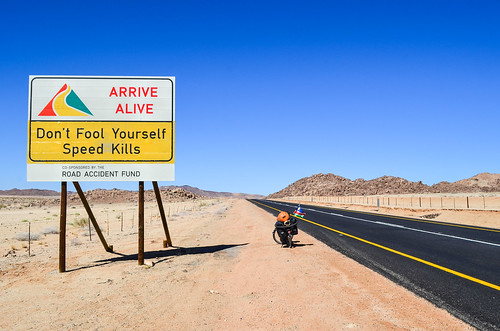
Das Streckenprofil oben zeigt es deutlich: mein Weg bis Steinkopf ständig bergauf geht. Ich möchte es zu Steinkopf, die nächste Stadt, um zu vermeiden, heute Abend von der Nationalstraße camping machen. Raue Sonne + 60 km bergauf + Einwanderung am Morgen = wenig Zeit, um im Leerlauf durch die Straße. Ich nehme nur wenige Pausen. Es gibt nichts viel zu sehen wie auch immer: ein Haus in Ruinen (= Schatten) und ein paar Feldwege führt zu sehr entlegenen Bauernhöfen oder Bergbau lagern.
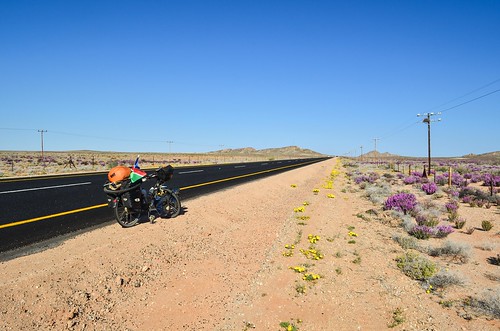
Ich denke an den Sicherheits-Tipps für Autofahrer in Südafrika: "Nehmen Sie keine Tramper, Don ' t stop um zu helfen, wenn Sie einen Unfall sehen, es ist ein Trick, berauben Sie usw.", aber ich wäre überrascht, wenn etwas hier passiert. Es gibt sehr wenig Verkehr auf diesem sehr lang und leer Weg, trotz des Seins die wichtigsten Fahrspur zwischen Namibia und Süd Afrika. Der Teer ist ganz neu und es gibt eine nützliche Schulter, ich gezwungen bin, wenn LKW mich überholen: sie bevorzugen vorbei nah an mir wie möglich dann eher die Gegenfahrbahn trotz bis Kilometer weggeräumt zu nutzen.

Diese Region wird genannt Namaqualand, der Heimat des Nama-Volkes, das von den Deutschen in Namibia massenhaft ermordet wurde. Namaqualand erstreckt sich tatsächlich auf beiden Seiten des Oranje-Flusses, und es stimmt, dass die Gegend, in der ich mich befinde, jetzt wie die flache und ziemlich langweilige Ostseite der Karas-Region in Namibia aussieht. Namaqualand ist in Südafrika viel beliebter, weil es mit Blumen in Verbindung gebracht wird: Im Frühling (August, September) besuchen viele Südafrikaner diese Region, um bunte Blumenteppiche zu sehen, die die kahle Landschaft einnehmen.
Ich habe viele Anzeigen über die Namaqualand Blumen, wo das Land sieht wie ein Mosaik aus Farben, aber es ist überhaupt nicht das, was ich sehe gerade jetzt. Vielleicht ist es zu früh, oder ich bin am falschen Ort. Nachdem einige lila in den Bereichen ist jedoch bereits eine große Veränderung.
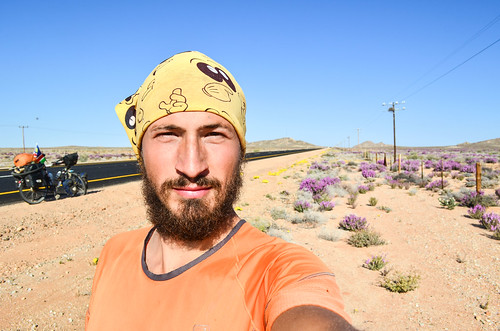
Und ich schaffe es nur für die Nacht nach Steinkopf. Es gibt einen Campingplatz am Ortseingang, aber das Camping ist "noch nicht fertig" und die Selbstversorger-Optionen sind ausgebucht. Was? Es gibt nichts zu sehen und der Ort ist ausgebucht? Viele Südafrikaner, Erwachsene und Kinder laufen herum. Die Rezeption sagt mir, dass sie aus dem ganzen Land bis hierher gekommen sind, um die Ruhe der Landschaft zu genießen. Nichts Besonderes, in der Tat ... aber zuerst überraschte es mich. Wann habe ich das letzte Mal gesehen, dass einheimische Touristen einen Platz gebucht haben? Sicherlich nicht in letzter Zeit. Aber ich kann Südafrika kaum mit West-/Zentralafrika vergleichen. Südafrika war bisher die größte Volkswirtschaft des Kontinents (Nigeria holte auf) und einer der wenigenAfrikanische Länder, die Touristen anziehen. Jede Lodge und Outdoor-Aktivität der Region hat einen Flyer an der Rezeption des Campingplatzes. Städte und Städte haben richtige Supermärkte und viele Geldautomaten. Wenn man es nur nach seiner Infrastruktur und seinen touristischen Einrichtungen bewertet, kann es leicht mit einem Land der Ersten Welt verwechselt werden.

I can abandon my “survival mode mindset” and worry less about mitigating all the risks linked to food / water / shelter / breakdowns. It’s funny, it’s a bit like the opposite of my impressions when I passed from Spain -> Morocco -> Mauritania -> Senegal. I was very excited on the way “into Africa”, so it feels now like I’m cycling out of it. In a way, the hardcore adventure is definitely over.
Der Platz ist zwar nicht geeignet, um Camper willkommen zu heißen, aber ich kann trotzdem auf ihrem Gelände bleiben. Der bequemste und flachste Boden, den ich finde, befindet sich tatsächlich in einem Haus im Bau (es ist wahrscheinlich die zukünftige Toilette des Pools), und ich schaffe es, mein Zelt darin aufzustellen. Zurück auf 850 m Höhe wird es eine kalte Nacht. Es ist auch lange her, dass ich nicht genau in den Himmel geschaut habe. Mit Hilfe meines Smartphone-Planetariums stelle ich fest, dass Mars und Saturn nahe beieinander liegen, neben Skorpion und Zentaurus. Diese beiden Sternbilder sind groß und schön (und der Skorpion sieht dem Tier, nach dem er benannt ist, ziemlich ähnlich) und nur am Südhimmel sichtbar.

Es war eine gute Idee, mein Zelt dort aufzustellen, da der Morgen so windig ist, dass mein Außenzelt stark flattert. Glücklicherweise kommt der Wind für den Rest des Tages aus Norden.
Die Straße vom Steinkopf ist die gleiche wie zuvor, aber sie hat keinen Seitenstreifen mehr. Autos, die mich überholen, hupen, vielleicht weil ich auf "ihrer" Spur bin, oder vielleicht zur Begrüßung, aber ich mag es nicht. Ich glaube, ich bin süchtig danach, auf unbefestigten Straßen zu radeln, weg von fast jedem Auto, und ich kann nicht mehr damit umgehen.
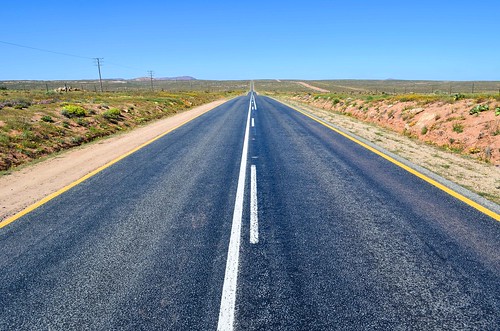

Es gibt einige Blumen. Nicht viele, aber es riecht manchmal nach Tee. Ich erwartete eine wilde Version von dem, was ich in Furano und Bieiwährend Fahrradtourismus in Hokkaido in Japan, aber es scheint, dass ich ein bisschen zu viel erwartet habe ... dennoch freue ich mich, nach so viel Wüste Farben zu sehen.


O'Kiep ist der erste Ort, der tatsächlich orange aussieht.
Auf den ersten plane nicht ich, diese Straße zu radeln. Dies ist der N7, der wichtigsten Nord-Süd Nationalstraße der Provinz, und ich dachte, es gäbe zu viel Verkehr. Bis Südafrikaner in Namibia hat mir gesagt, dass es sehr ruhig ist (es ist wirklich ruhig und langweilig), hatte ich überlegt, Radfahren entlang der Küste. Am nördlichen Kap gibt es eine Parallelstraße vom Atlantischen Ozean, durch viele kleine Bergstädte. Bereich ist ähnlich wie das Sperrgebiet in Namibia: trocken, leer, und vor allem für Bergbau Diamanten verwendet. Da es unmöglich ist für Besucher in das Sperrgebiet, ich weiß nicht, ob Südafrika erfordert eine Genehmigung oder so etwas, diese Straße zu benutzen. Auf Satellitenbildern sieht es zumindest faszinierend: Fast jeder einzelne der 150 Kilometer langen Küstenlinie zwischen Alexander Bay, an der Grenze zu Namibia, und Kleinzee, südlich von Port Nolloth, ist von Bergbauaktivitäten gezeichnet. Er breitet sich sogar noch weiter südlich bis nach Koingnaas und Hondeklip Bay aus.

Am frühen Nachmittag erreiche ich Springbok, die grösste Stadt Namaqualands mit knapp über 10'000 Einwohnern. Es ist Sonntag, und es fühlt sich an, als wären alle weg.

Die Hauptstraße ist die Voortrekker Street, benannt nach den ersten afrikanischen Siedlern. Da ich erst in der Nähe von Kapstadt eine so "große" Stadt sehen werde, beschließe ich, hier zu übernachten und mir eine SIM-Karte zu besorgen, sobald die Geschäfte morgen öffnen.

Während ich mich auf der Hauptstraße bewege, bemerke ich, dass ein Tuck Shop geöffnet ist. Es ist ein Inder, der an seinem Schreibtisch einen Bollywood-Film anschaut und eiskalte Cola verkauft, während ich mich im Schatten seines Ladens erfrische und die sehr geringe Bewegung auf der Hauptstraße beobachte. Und er verkauft zufällig auch MTN-SIM-Karten. MTN ist meine Lieblingsmarke, die am schnellsten in Westafrika funktioniert."aber ich müsste es registrieren, bevor ich es verwenden kann, oder?“. Der Ladenbesitzer antwortet, dass die SIM-Karte "vorregistriert" ist.
Wie funktioniert es? Setzt Südafrika SIM-Registrierung mit einer ID, Verbrechen zu verhindern, und am anderen Ende, verkaufen Leute sie vorregistriert? Es macht keinen Sinn und es ist wahrscheinlich ein Betrug. In der Vergangenheit habe ich meinen Anteil an verlorenen Stunden versucht, SIMs, die Arbeit zu machen, aber für 5 Rands, bin ich zu neugierig, sie gehen zu lassen.
Ich versuche die SIM-Karte sowieso, und es funktioniert tatsächlich. Internet, hier sind Sie! Und ich brauche nicht mehr in der Stadt zu bleiben. Beim Hantieren mit den MTN USSD-Menüs auf dem Bürgersteig, hält ein Auto vor mir und eine Dame fragt: "Sind Sie der Radfahrer soll ich abholen?"Hem... Nein, nicht das ich kenne... "Okay, bleib einfach da, ich komme zurück“.
Ein paar Minuten später kommt Davida zurück, gefolgt von einem anderen Radfahrer. Es ist Jakkie, in seinen Siebzigern, Radfahren 5000 KM entlang der Grenze Südafrikas und Fundraising für das Institute for the Blind. Es ist ziemlich beeindruckend, und Davida bietet mir spontan an, mich aufzunehmen. Zwei Radfahrer zum Preis von einem.
Und es ist noch nicht vorbei: Jakkie wird von zwei weiteren Radfahrern aus Pretoria begleitet, die erst heute angekommen sind, so dass wir eigentlich sechs sind, darunter vier Radfahrer. Das ist perfekt für einen leckeren Braai! Namibia war köstlich für das Fleisch, ebenso wird Südafrika besser von Nicht-Vegetariern genossen. In Namibia ist es anscheinend billiger und schmackhafter (nach meinen Berechnungen wachsen derzeit auf namibischem Boden 35 kg Oryx-Fleisch pro Einwohner in freier Wildbahn), aber die Bevölkerung Südafrikas beträgt 53 Millionen, und wenn die Menschen auf meiner Straße so gastfreundlich sind wie Davida, bin ich 25-mal wahrscheinlicher zum Braai!
Ihr Mann war früher in der SADF, der südafrikanischen Armee, die in den nicht so ruhmreichen Jahren der Geschichte des Landes sehr aktiv war. Ich habe mich für ein Plakat im Haus interessiert:
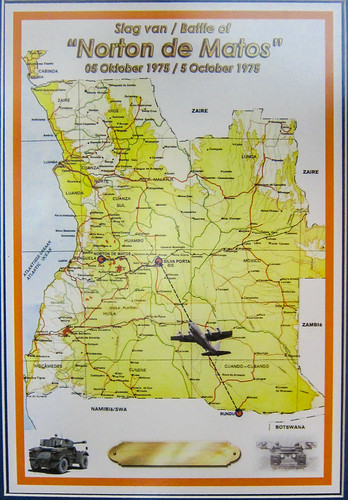
Der Punkt, der Norton de Matos auf der Karte anzeigt, ist eigentlich Balombo (Krieg-Karte), in der Nähe von Benguela. Balombo? Ich war dort vor einem halben Jahr. Ich wurde in der katholischen Mission untergebracht und zu den heißen Quellen von Kotakota gebracht, die von einem großen Herrenhaus in Ruinen auf einem Hügel überragt werden.
Wir haben damals nicht über den angolanischen Krieg gesprochen, aber ich habe Angolaner getroffen, die mir Geschichten über Kugeln, Landminen und Flugzeuge erzählten, die Bomben auf ihre Köpfe abwarfen. In Balombo hätte ich mir nicht vorstellen können, dass ich 2400 KM weiter bei jemandem wohnen würde, der an diesem Krieg teilgenommen hat, aber auf dem anderen Lager. Südafrika bot der UNITA militärische Unterstützung an, die auch finanzielle Unterstützung von den USA, Frankreich und China erhielt. Sie wurden schließlich von der MPLA des derzeitigen Präsidenten Dos Santos besiegt, die von Kuba und der Sowjetunion unterstützt wurde.
Vierzig Jahre später (und 12 Jahre nach Kriegsende) ist die Wunde immer noch frisch, die verlassenen Panzer liegen immer noch an der Straße und die Kugelnarben an einigen Häusern. Ich wurde beschuldigt, UNITA zu sein, während ich in Angola Rad fuhr. Aber einige südafrikanische Ex-Militärs haben bereits zu Besuch gestattet.
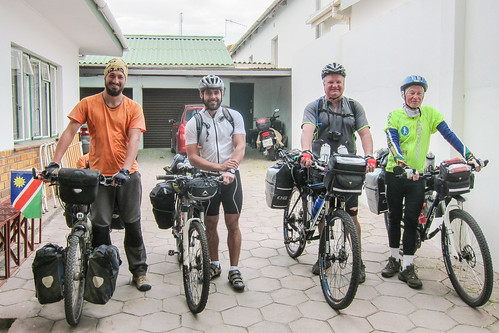
Antonie und John kommen zu uns, wir fahren jetzt alle nach Kapstadt. Das Fleisch und der Brandy gingen die Beine hinunter, ein gutes Frühstück gibt es für den Tag, und ich gehe viel früher als früher.
Jakkie ist sehr diszipliniert, in einer sehr guten Form und hat immer einen Plan für die Nacht. Wir fahren heute nach Kamieskroon, der nächsten kleinen Stadt (1000 Seelen) an der N7, und kommen recht früh an.


Der Teer ist gut, aber mit vielen Höhen und Tiefen. Es gibt immer noch keinen Seitenstreifen an den Seiten, nach der gelben Linie, und mehrere Autos hupen uns immer noch an. Es ist definitiv eine Begrüßung, die John zu schätzen weiß, aber ich glaube nicht, dass ich mich jemals daran gewöhnen werde.
Es ist ziemlich windig und es gibt nicht viele Blumen.
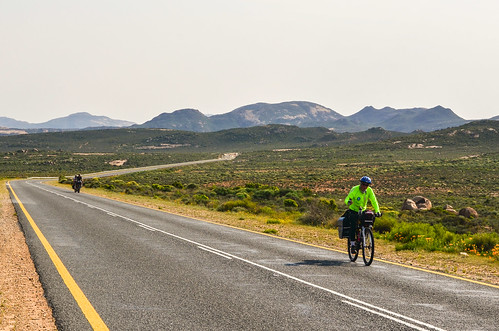
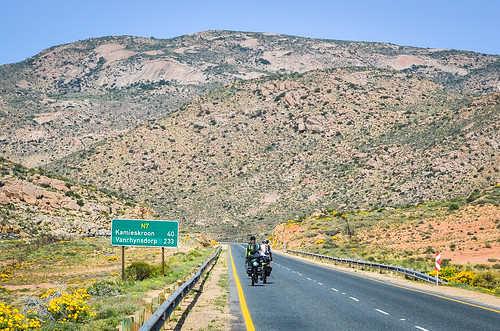

Und schließlich kann ich die gleichen Bilder machen, die ich in Flugblättern gesehen habe, die für Namaqualand werben.


Aber es ist eigentlich nicht so häufig.
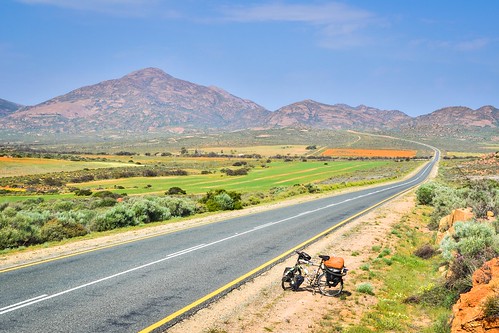
Wir halten 10 km vor Kamieskroon in einem Selbstversorgerhaus, das Jakkie organisiert hat, und haben genügend Zeit, Fleisch und Holzkohle für den Braai zu kaufen. Antonie muss eine Mitfahrgelegenheit zurück nach Springbok finden, um sein Hinterrad neu zu speichen und auszurichten, da er nicht über die Werkzeuge verfügt, um seine Kassette zu entfernen (das ist ein weiterer Bonuspunkt für die Rohloff-Speedhub! Speichen haben eine ungewöhnliche Länge, können aber schnell gewechselt werden).
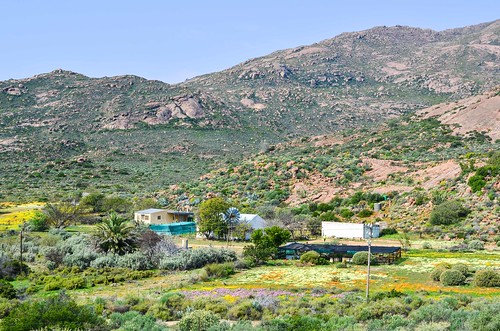
Antonie und John tragen nicht so viel Gepäck und Werkzeug wie ich, aber sie haben einen unschätzbaren Ausrüstungsgegenstand: eine selbstdosierende Plastikflasche für Brandy. Pap und Braai lassen den Tag ausklingen.
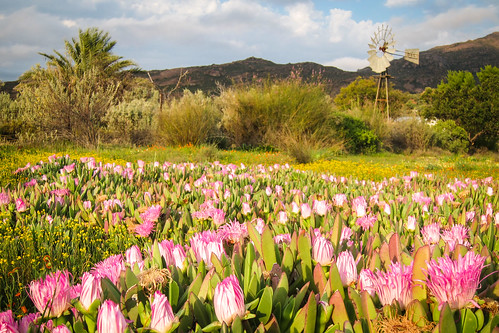
Der Morgen ist kalt und bewölkt, und es sieht aus wie ein europäischer Herbst in den Bergen. Wir radeln schnell nach Kamieskroon, wo ich eine große Menge Vetkoek einpacke, die mich für den ganzen Tag stärken sollte. Vetkoeks sind fast die gleichen wie die frittierten Teigbeignets, die ich seit Guinea in jedem Land unter verschiedenen Namen hatte. Es ist wahrscheinlich das einzige Lebensmittel, das ich weiter verbreitet gesehen habe als Maniok/Maniok.
Aber ich werde nicht mit meiner neuen Radsportmannschaft mithalten. Die N7 Straße ist ziemlich langweilig, ich mag immer noch keine Autos, und wenn ich etwas Südafrika sehen will, sollte ich nicht dort bleiben. Stattdessen führt eine parallele Schotterstraße in den Pässen und Hügeln hinauf. Die anderen beschließen, auf dem Asphalt zu bleiben, also treffen wir uns heute Abend in Garies wieder, 60 km später für sie, 90 km später für mich.

Diese Straßenschilder veranschaulichen auch das breite Spektrum des Gastgewerbes, so viele Betten für eine Stadt mit 1000 Einwohnern. Ist das nur für die Blumensaison?
Kamieskroon ist eine Stadt, die 1924 umgesiedelt wurde, weil der ursprüngliche Standort, der am Ende eines Tals in der Nähe unserer Unterkunft lag, zu eng wurde. Kroon bedeutet Krone und bezieht sich auf einen Felsen auf der Spitze des Gipfels, der die Stadt überragt.
Und das ist hinter dem Kroon, den mich mein Weg über Leliefontein nach Garies führt.

Unmittelbar nach dem Verlassen von Kamieskroon ersetzt die unbefestigte Straße den Teer und steigt 8 km lang an. Es ist der Kamiesbergpass.

Oben ist es ein Plateau mit Blumen, Kühen und Bauernhöfen. Ah, viel besser als das N7.


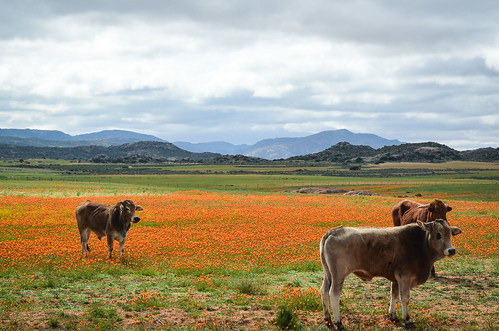

Kamieskroon lag auf 750 m, und es geht immer noch bergauf. Ich werde schließlich 1350 m erreichen. Gut gemacht, denn als ich den Oranje-Fluss passierte, dachte ich nicht, dass ich wieder über 1000 m kommen würde.

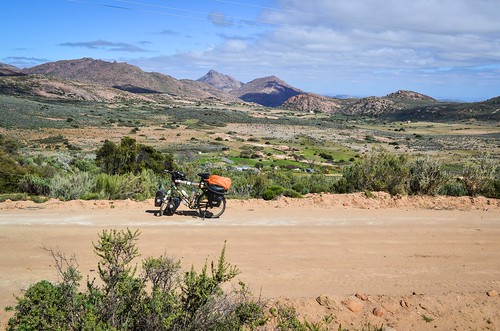
Ich drücke dieses Mal, bin ziemlich müde und auch müde, das nie zu sehen Leliefontein. Tatsächlich ist die Stadt direkt hinter den Funkmasten versteckt. Es ist das älteste Dorf von Namaqualand und die Heimat einer Nama-Gemeinschaft (während der Apartheid war es ein "farbiges Reservat"), einer methodistischen Kirche und einer Mission. Es ist ein ziemlich großes Dorf für eine Stadt, die nicht einmal auf einigen Karten erscheint, und trotz der kalten Temperaturen treibt mich dieser Hang direkt in einen Laden. Zum Glück gibt es eine mit reichlich kalter Cola, danke Strom.
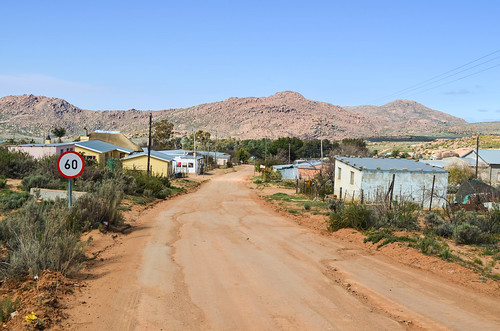

Die Stadt liegt auf 1350 m Höhe, und der Ladenbesitzer erzählt mir, dass es dieses Jahr dreimal geschneit hat. Ich dachte, dass es im südlichen Afrika nur in Lesotho und der Umgebung der Drakensberge schneit, aber jetzt weiß ich, dass es auch in Windhoek, im Khomas-Hochland und sogar im Namaqualand schneien kann (vielleicht aber nicht jeden Winter). Er sagt mir auch, dass es von nun an nur noch bergab gehen soll bis zum Ende. Gute Nachricht!

Es gibt einige Bauernhöfe und nicht viel mehr, und es ist eine hübsche Landschaft. Man könnte in der Tat sagen, dass es wie in Namibia ist. Aber nass (für namibische Verhältnisse).
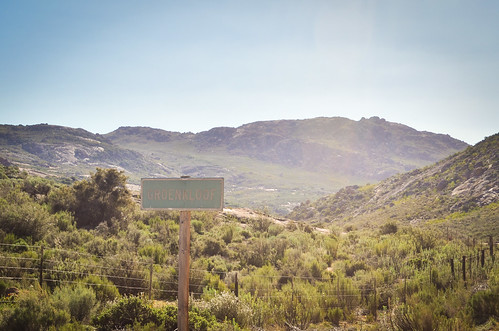
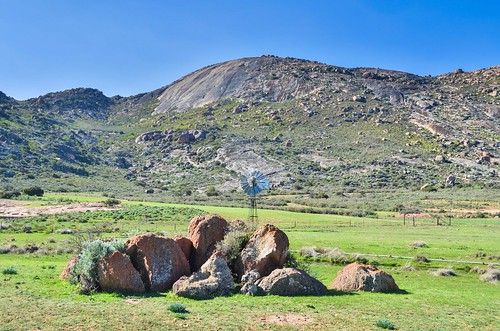

Es ’ s ganz grün hier oben und die Satellitenbild zeigt gut das Ackerland rund um die Straßen und Flüsse. Übrigens, als ich die Umgebung mit Satellitenbildern erkundete (zum Zeitpunkt des Schreibens), bemerkte ich etwas verdächtiges in der Nähe von Platbakkies: ein Landstreifen, ein Gebäude, ein paar geometrische Straßen, Löcher mit präziser Geometrie mitten im Nirgendwo und sonst nichts. Es sieht für mich zu sauber aus, um unschuldiges Ackerland zu sein, und es erinnert mich an etwas, das Mark mir zuvor gezeigt hatte: die Vastrap Militärflugplatz und unterirdisches Atomwaffentestgelände, in der Kalahari(d.h. auch mitten im Nirgendwo). Dort wurden 1993 zwei 1979 gebohrte Schächte mit einer Tiefe von bis zu 385 m abgedichtet. Es wird gesagt, dass dort nie eine Detonation stattgefunden hat, aber andererseits ist es immer noch unklar, ob Südafrikaner oder Israelis oder beide hinter dem 1979Vela-Doppelblitz im Südatlantik.
Zurück zu meiner verdächtigen Infrastruktur auf der Karte in Namaqualand: Ein wenig Recherche (OpenStreetMap ist großartig dafür) lässt mich das einzige radioaktive Abfalllager des Landes "entdecken": Es ist Vaalputs, und ihre Website zeigt sie Gelbe Fässer zu begraben von Atommüll aus Koeberg (dem einzigen Kernkraftwerk des Kontinents, das ich auf meinem Weg nach Kapstadt sehen werde) in einem Land, das im Grunde als verlassen beschrieben wird, abgesehen von der Schafzucht. Wenn Necsa (der Atomkonzern) mit der gleichen Schlamperei geführt wird wie Eskom (der Hauptenergieproduzent), könnte ich am Ende Superhelden-Muskeln haben, weil ich bereit bin, eine Million Lammkoteletts zu essen. (Nur ein Scherz, meine Beine sind bereits mit Superhelden-Muskeln ausgestattet).
Ich will nicht die Atomanlagen Südafrikas ausspionieren (es scheint schwieriger zu sein, einen einzigen Schacht in der Karoo oder der Kalahari zu verstecken als eine ganze Stadt im Dschungel der Demokratischen Republik Kongo), aber vor drei Jahren joggte ich zufällig durch die Necsa-Forschungszentrum in Pelindaba, in der Nähe von Pretoria. Der Hennops-Pfad bietet einen schönen Blick auf die Anlagen, zu denen ein Mini-Kernreaktor und die Gebäude gehören, in denen die Südafrikanische Atombombe(vielleicht wahr, vielleicht gefälscht, viele Geschichten mit Israel, aber die Bilder sind einen Blick wert).

Die echte Abfahrt erfolgt über die Studer ’ s-Pass, eine wirklich beeindruckende: 15 km bergab, von 1000 m auf 300 m, am Rande des Berges, viel Wasser, Fluss und Pfannen, nur wenige Autos, und ab und zu blauer Himmel. Es ist sogar noch erstaunlicher, weil ich nichts so Schönes erwartet habe.
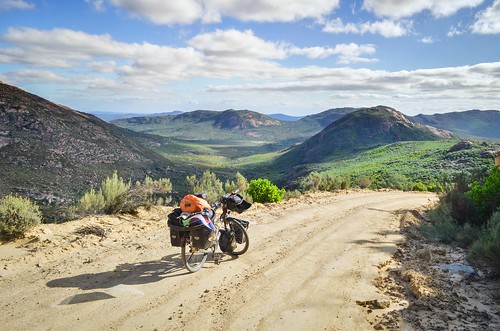

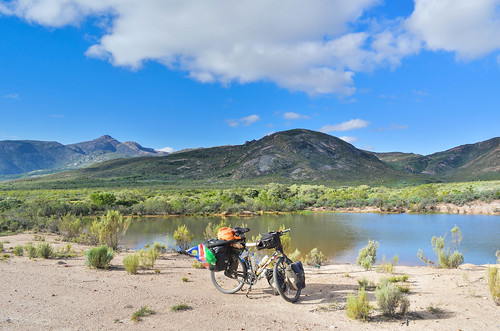
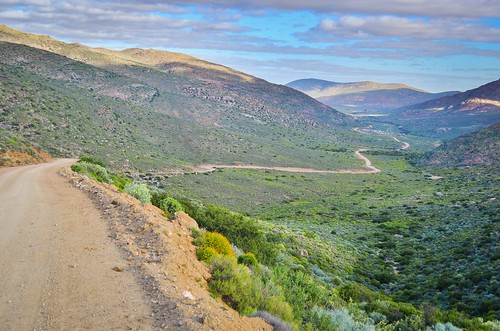


Es wird Nacht nach der anderen, und ich habe noch 10 km Feldweg vor mir, bevor ich Garies erreiche. Es ist ein sehr langer Tag! Insgesamt sind 80 meiner 90 km heute auf Feldwegen, und die letzten Teile sind gewellt. Namibia kann es besser. Ich komme an einem kleinen Wollastonit meine, ein Kilomilestone-Foto für meine 26000 KM machen und schließlich in die Stadt kommen, wo ich Jakkie, Antonie und John finde. Ich hatte einen ziemlich intensiven Tag und eine daraus resultierende Kilometerleistung, wenn man den Straßenbelag und das Höhenprofil bedenkt, und trotz meiner Erschöpfung bin ich sehr aufgeregt, es nach Garies geschafft zu haben und sie wiederzutreffen. Unsere gastfreundlichen Gastgeber sind Toelie und Tanya, die uns mit viel leckerem Fleisch verwöhnen. Ein weiteres Abendessen in Südafrika, ein weiteres Braai. Meine Augen, mein Bauch und meine Beine sind zu 100% zufrieden!







Faszinierender Beitrag – wie immer. Vielen Dank!
Danke! Jetzt, wo ich zu Hause bin, mit viel schnellem Internet, kann ich a posteriori mehr lernen und es in die Geschichte einbauen.
Als nächstes werde ich meine namibischen Videos veröffentlichen, damit ihr etwas von der Landschaft erkennen solltet. Ich habe jedoch nicht die Kamanjab-Route genommen.
Jean, es war eine Überraschung, als ich dich an jenem Sonntagnachmittag, dem 17. August 2014, sah, als ich Springbok betrat. Du bist so ein erstaunlicher Mensch, mit "Mut" und viel Enthusiasmus und Ausdauer.
It was a pleasure to meet and ride with you. I am still sorry that I didn’t ride with you from Kamieskroon via Lieleifontein to Garies. That day was Jean’s – John as you call him, his 23rd birthday and I think he and Antonie were in a sort of hurry to get to Garies. There’s a hotel as can be expected. Never the less, it was a pleasant stay at Toelie and Tany’s and we all enjoyed their hospitality.
Richtig, er ist Jean. Ich hatte "John" in meine täglichen Notizen geschrieben, also beschloss ich, es "auf die tägliche Weise" zu belassen. Es ist nicht einfach, "wie in der Gegenwart" zu schreiben, während es vor 6 Monaten passiert ist. In dieser Geburtstagsnacht waren unsere beiden Luftmatratzen am Morgen entleert, nicht gut, um sich richtig zu erholen!
Amigo! Ich bin so stolz und freue mich für dich... Du bist ein großartiger Krieger.
Ich hoffe, wir sehen uns bald in Europa. Ich bin im Moment in Norwegen.. Demnächst nach Schottland reisen.
Beste Wünsche für Sie... Wo bist du?
Already home, I’m retro-blogging now to finish the story. It’s easier to do it with internet rather than on the road!
I see you like these icelandic-like raw landscapes, I hope you have good weather.